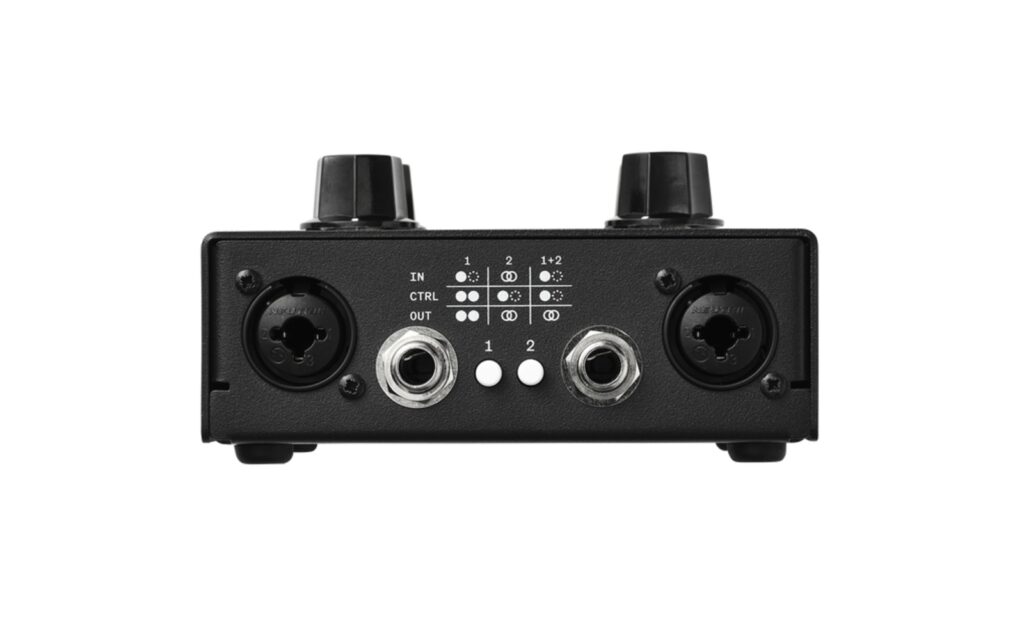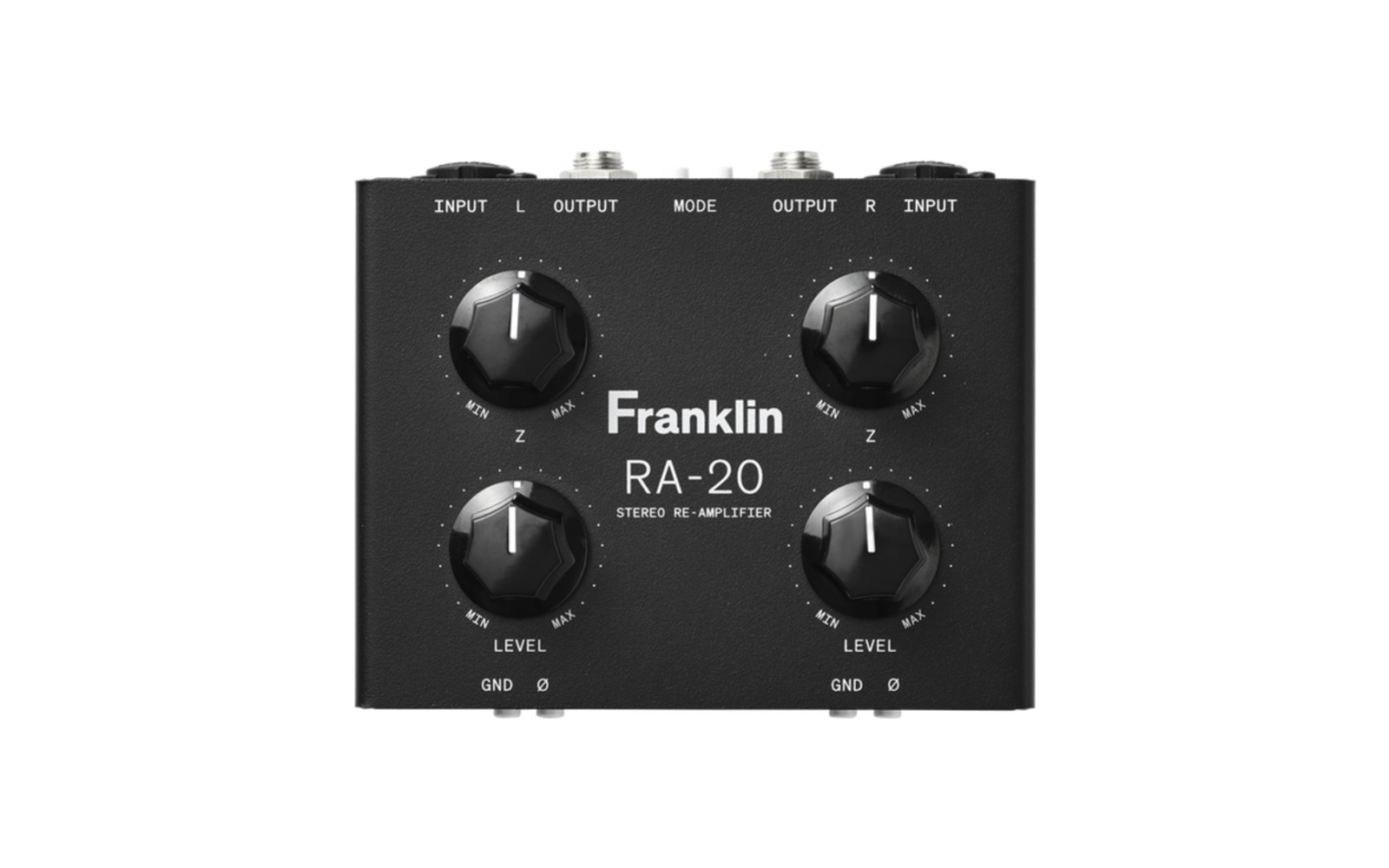Franklin Audio are doing the lord’s work in their RA-10 and RA-20 Studio Re-Amplifiers, the RA-20 being a stereo version of the RA-10.
The RA-20 is designed and built in Sydney, Australia, with a robust, bent metal chassis encasing comprehensive circuitry and two custom-wound transformers, the unit itself weighing just 0.6kg. The unit from Franklin Audio responds from 10Hz up to 30kHz, meaning every ounce of your signal’s tone, and then some, will be unaffected! Robust knobs allow for control, while the switching options for routing are tucked out of the way to prevent being accidentally bumped while using the unit.
In a nutshell, these are boxes that convert a line level signal to instrument level, allowing you to take a recorded signal, i.e. within your DAW, and play it back through an amplifier at an optimum level for the amplifier itself. This process is called re-amplifying, as that signal can be re-recorded when played from the guitar amplifier and speaker cabinet. Franklin Audio offers the RA-10, a single-channel, mono unit, or the dual-channel RA-20, that offers both mono and stereo operation.
Read up on all the latest interviews, features and columns here.
Where things get a bit more creative, is when using the RA-20, for example, to run line level signal into a guitar pedal instead of an amplifier. For example, with the RA-20, you’re able to route your drum bus into the RA-20, with ‘Z’ (impedance) and level controls to a stereo delay pedal, overdrive or chorus, into an instrument/Hi-Z input on your interface, or a DI (to convert it back to line level) and back into your DAW. With the RA-20, your pedals can now work as outboard for producing, recording and mixing!
The RA-20 features two ins and outs, as well as a simple (yet very comprehensive!) switching system that allows for various routing like dual mono, true stereo, mono to stereo operation and mono to dual mono. The RA-20’s input is via two Neutrik combo XLR/¼” connections, with output via two ¼” Neutrik TS jacks.
The RA-20 also features independent ground switches and a phase flip switch on each channel, to keep everything controlled, in phase and hum free!
Each side features a ‘Level’ control, as well as a ‘Z’ control for impedance matching (or further tonal control if you’d like to get creative!) The ‘Level’ control is actually a passive trim for each channel, so having this set to ‘Max’ would be default, allowing you to ensure the signal going to the next part of your chain is optimal. The RA-20 (and RA-10 for that matter) feature a transformer balance circuit with custom-wound Franklin audio transformers.
In use— the RA-20 is a great solution for re-amping. Don’t let the layout’s simplicity trick you, this unit features as comprehensive a control as you’d ever need, seemingly having more control over tone than other re-ampers. As mentioned earlier, things get really creative when using the RA-20 to re-amp signal through pedals— the RA-20’s compact form factor allowing it to easily be nestled in beside pedals, and I was immediately mixing with my drums through otherworldly reverb pedals and experimenting with the ‘Z’ control, while also destroying my kick drums transients with distortion and overdrive.
The stereo capabilities of the RA-20 make it especially useful, stereo delay pedals being a great way to access gritty, bucket brigade delays in my mixing.
The switchable mono and stereo modes really elevated the RA-20, and while reading the switching options in the manual took a moment to wrap my head around, you’ve got access to everything you’d need. Dual Mono mode makes both sides of the pedal work independently of one another, while Mono to Dual Mono mode allows a single signal to be sent into the left input, with that signal being routed to each output with independent ‘Level’ controls. True Stereo allows for two inputs and outputs, with both sides controlled by the left side controls, meaning you don’t need to meticulously match the sides’ settings. Mono to Stereo mode differs from Mono to Dual Mono in that the mono signal is split, yet both outputs are controlled by just the left side controls for perfectly matched outputs.

At a glance: this allows you to use both mono and stereo pedals, or—back to the example of re-amping through amplifiers, send a single, mono, guitar signal into two guitar amplifiers, either in a true stereo setting to ensure each amp is receiving exactly the same sound, or in dual mono operation to further optimise the signal that each amp receives. You can sum two performances into a mono output, i.e. into one amplifier, to harness the grit and push of a guitar amplifier for a more bolstered sound. This also applies to re-amping a stereo synth through amplifiers, either mono or stereo, for example if you’d like to push a little air out of a speaker with a digital soft synth.
The capabilities of this unit are really limited by your imagination, so if, after all this, you’re still struggling to see the merit of Franklin Audio’s RA-20 Stereo Re-Amplifer, maybe you can’t be helped!
For more info and local enquires, keep reading at Franklin Audio.

